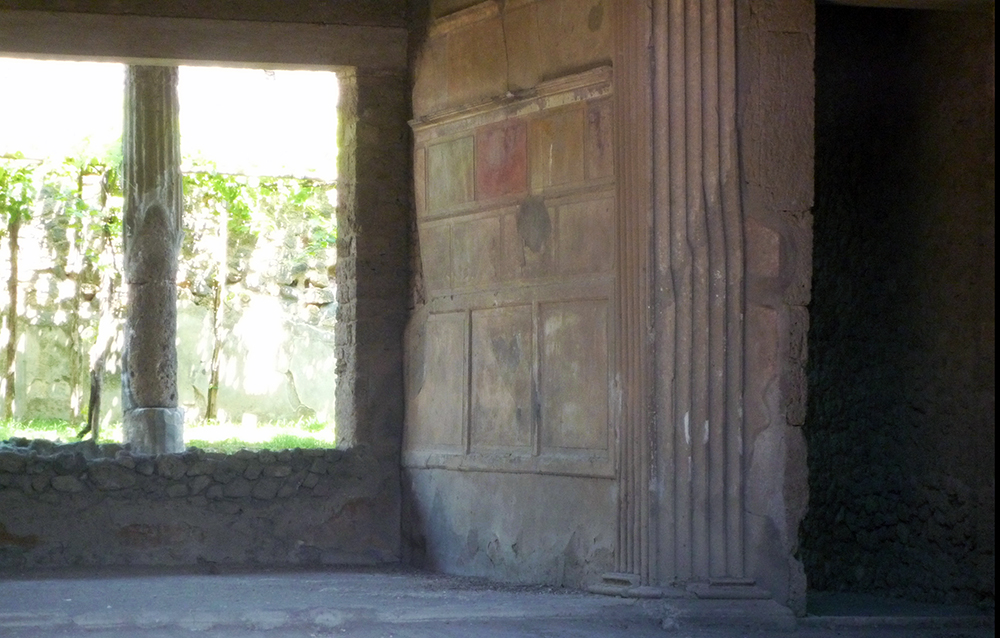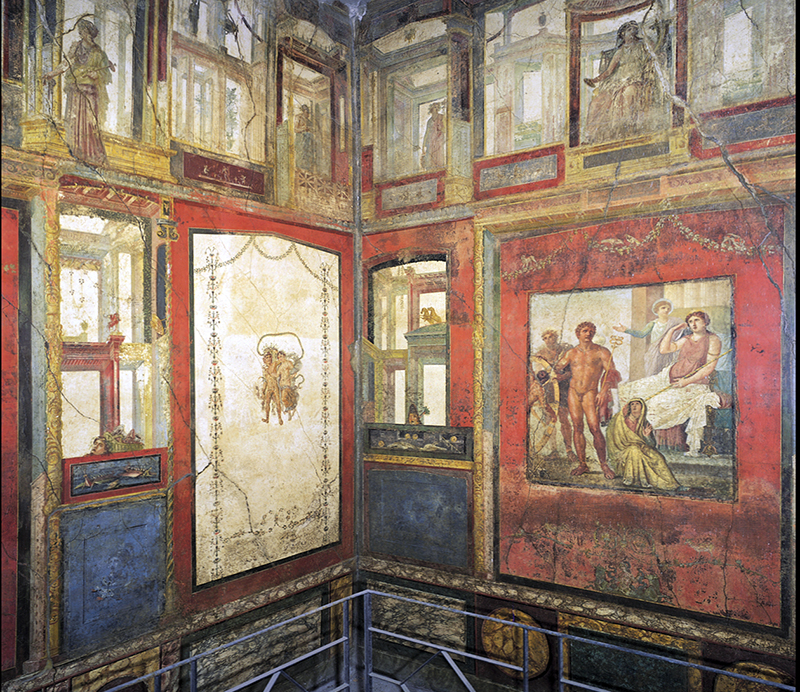Mount Vesuvius buried Pompeii two millennia ago—creating a time capsule of the evolution of Roman painting.

Example of a Fourth Style painting, before 79 C.E., fresco, Pompeii
Why Pompeii?
Paintings from antiquity rarely survive—paint, after all, is a much less durable medium than stone or bronze sculpture. But it is thanks to the ancient Roman city of Pompeii that we can trace the history of Roman wall painting. The entire city was buried in volcanic ash in 79 C.E. when the volcano at Mount Vesuvius erupted, thus preserving the rich colors in the paintings in the houses and monuments there for thousands of years until their rediscovery. These paintings represent an uninterrupted sequence of two centuries of evidence. And it is thanks to August Mau, a nineteenth-century German scholar, that we have a classification of four styles of Pompeian wall painting.

View of Mount Vesuvius from Pompeii
The four styles that Mau observed in Pompeii were not unique to the city and can be observed elsewhere, like Rome and even in the provinces, but Pompeii and the surrounding cities buried by Vesuvius contain the largest continuous source of evidence for the period. The Roman wall paintings in Pompeii that Mau categorized were true frescoes (or buon fresco), meaning that pigment was applied to wet plaster, fixing the pigment to the wall. Despite this durable technique, painting is still a fragile medium and, once exposed to light and air, can fade significantly, so the paintings discovered in Pompeii were a rare find indeed.

Example of First Style painting, House of Sallust, Pompeii, built 2nd century, B.C.E.
In the paintings that survived in Pompeii, Mau saw four distinct styles. The first two were popular in the Republican period (which ended in 27 B.C.E.) and grew out of Greek artistic trends (Rome had recently conquered Greece). The second two styles became fashionable in the Imperial period. His chronological description of stylistic progression has since been challenged by scholars, but they generally confirm the logic of Mau’s approach, with some refinements and theoretical additions. Beyond tracking how the styles evolved out of one another, Mau’s categorizations focused on how the artist divided up the wall and used paint, color, image and form—either to embrace or counteract—the flat surface of the wall.

Example of First Style painting, House of the Faun, Pompeii, built 2nd century, B.C.E. (photo: Steven Zucker, CC BY-NC-SA 2.0)
First Pompeian Style
Mau called the First Style the “Incrustation Style” and believed that its origins lay in the Hellenistic period—in the 3rd century B.C.E. in Alexandria. The First Style is characterized by colorful, patchwork walls of brightly painted faux-marble. Each rectangle of painted “marble” was connected by stucco moldings that added a three-dimensional effect. In temples and other official buildings, the Romans used costly imported marbles in a variety of colors to decorate the walls.

Detail of faux marble, Villa of the Mysteries, before 79 C.E., fresco, just outside the walls of Pompeii on the Road to Herculaneum (photo: Steven Zucker, CC BY-NC-SA 2.0)
Ordinary Romans could not afford such expense, so they decorated their homes with painted imitations of the luxurious yellow, purple and pink marbles. Painters became so skilled at imitating certain marbles that the large, rectangular slabs were rendered on the wall marbled and veined, just like real pieces of stone. Great examples of the First Pompeian Style can be found in the House of the Faun and the House of Sallust, both of which can still be visited in Pompeii.
Second Pompeian style
The Second style, which Mau called the “Architectural Style,” was first seen in Pompeii around 80 B.C.E. (although it developed earlier in Rome) and was in vogue until the end of the first century B.C.E. The Second Pompeian Style developed out of the First Style and incorporated elements of the First, such as faux marble blocks along the base of walls.

Example of Second Style painting, cubiculum (bedroom), Villa of P. Fannius Synistor at Boscoreale, 50–40 B.C.E., fresco 265.4 x 334 x 583.9 cm (The Metropolitan Museum of Art)
While the First Style embraced the flatness of the wall, the Second Style attempted to trick the viewer into believing that they were looking through a window by painting illusionistic images. As Mau’s name for the Second Style implies, architectural elements drive the paintings, creating fantastic images filled with columns, buildings and stoas.

Example of Second Style painting, cubiculum (bedroom), Villa of P. Fannius Synistor at Boscoreale, 50–40 B.C.E., fresco (The Metropolitan Museum of Art)
In one of the most famous examples of the Second Style, P. Fannius Synistor’s bedroom (now reconstructed in the Metropolitan Museum of Art), the artist utilizes multiple vanishing points. This technique shifts the perspective throughout the room, from balconies to fountains and along colonnades into the far distance, but the visitor’s eye moves continuously throughout the room, barely able to register that he or she has remained contained within a small room.

Example of Second Style painting, view of the Dionysiac frieze, Villa of the Mysteries, before 79 C.E., fresco, 15 x 22 feet, just outside the walls of Pompeii on the Road to Herculaneum (photo: Steven Zucker, CC BY-NC-SA 2.0)
The Dionysian paintings from Pompeii’s Villa of the Mysteries are also included in the Second Style because of their illusionistic aspects. The figures are examples of megalographia, a Greek term referring to life-size paintings. The fact that the figures are the same size as viewers entering the room, as well as the way the painted figures sit in front of the columns dividing the space, are meant to suggest that the action taking place is surrounding the viewer.
Third Pompeian Style
The Third Style, or Mau’s “Ornate Style,” came about in the early 1st century C.E. and was popular until about 50 C.E. The Third Style embraced the flat surface of the wall through the use of broad, monochromatic planes of color, such as black or dark red, punctuated by minute, intricate details.

Example of Third Style painting, panel with candelabrum, Villa Agrippa Postumus, Boscotrecase, last decade of the 1st century B.C.E. (The Metropolitan Museum of Art)
The Third Style was still architectural but rather than implementing plausible architectural elements that viewers would see in their everyday world (and that would function in an engineering sense), the Third Style incorporated fantastic and stylized columns and pediments that could only exist in the imagined space of a painted wall. The Roman architect Vitruvius was certainly not a fan of Third Style painting, and he criticized the paintings for representing monstrosities rather than real things, “for instance, reeds are put in the place of columns, fluted appendages with curly leaves and volutes, instead of pediments, candelabra supporting representations of shrines, and on top of their pediments numerous tender stalks and volutes growing up from the roots and having human figures senselessly seated upon them…” (Vitr.De arch.VII.5.3) The center of walls often feature very small vignettes, such as sacro-idyllic landscapes, which are bucolic scenes of the countryside featuring livestock, shepherds, temples, shrines and rolling hills.

Example of Third Style painting, panel with candelabrum (detail with Egyptian motif ), Villa Agrippa Postumus, Boscotrecase, last decade of the 1st century B.C.E. (The Metropolitan Museum of Art)
The Third Style also saw the introduction of Egyptian themes and imagery, including scenes of the Nile as well as Egyptian deities and motifs.
Fourth Pompeian Style
The Fourth Style, what Mau calls the “Intricate Style,” became popular in the mid-first century C.E. and is seen in Pompeii until the city’s destruction in 79 C.E. It can be best described as a combination of the three styles that came before. Faux marble blocks along the base of the walls, as in the First Style, frame the naturalistic architectural scenes from the Second Style, which in turn combine with the large flat planes of color and slender architectural details from the Third Style. The Fourth Style also incorporates central panel pictures, although on a much larger scale than in the third style and with a much wider range of themes, incorporating mythological, genre, landscape and still life images. In describing what we now call the Fourth Style, Pliny the Elder said that it was developed by a rather eccentric, albeit talented, painter named Famulus who decorated Nero’s famous Golden Palace. (Pl.NH XXXV.120) Some of the best examples of Fourth Style painting come from the House of the Vettii which can also be visited in Pompeii today.

Example of Fourth Style painting, Ixion Room, House of the Vetii, Pompeii, 1st century C.E.
Post-Pompeian painting: What happens next?
August Mau takes us as far as Pompeii and the paintings found there, but what about Roman painting after 79 C.E.? The Romans did continue to paint their homes and monumental architecture, but there isn’t a Fifth or Sixth Style, and later Roman painting has been called a pastiche of what came before, simply combining elements of earlier styles. The Christian catacombs provide an excellent record of painting in Late Antiquity, combining Roman techniques and Christian subject matter in unique ways.
Additional Resources:
Roman Painting on the Heilbrunn Timeline of Art History
Joanne Berry, The Complete Pompeii (London: Thames & Hudson, 2013).
John R Clarke, The Houses of Roman Italy, 100 B.C.-A.D. 250: Ritual, Space, and Decoration. (Los Angeles: University of California Press, 1991).
Roger Ling. Roman Painting (New York: Cambridge University Press, 1991).
August Mau. Pompeii: Its Life and Art. Translated by Francis W. Kelsey. (New York: The MacMillan Company, 1902). (Available on Kindle)
Smarthistory images for teaching and learning:
[flickr_tags user_id=”82032880@N00″ tags=”RomanPtg,”]

